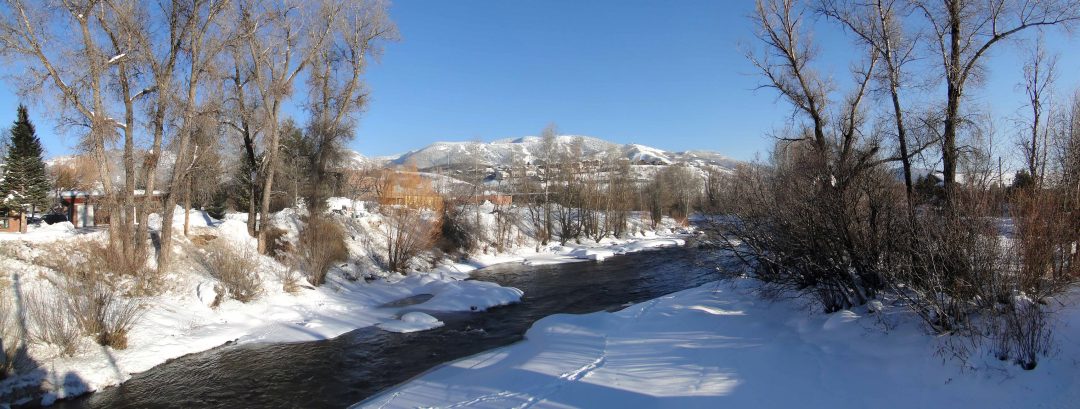The calendar might say April, but the snow continues to fall in Steamboat, adding to a record snowpack we haven’t seen in over 10 years. “At this point our snowpack does look good, and we have obviously spent a lot of time clearing snow this winter here in Steamboat,” says Holly Kirkpatrick, Public Information & External Affairs Manager for the Upper Yampa Water Conservancy District. “Right now, we are sitting at 147 percent of the median snowfall over a 30-year average.”
As the organization that manages water storage for Stagecoach and Yamcolo reservoirs and other resources in the district to conserve, protect, develop and enhance the resources of the Yampa River Basin, Kirkpatrick is a realist when it comes to seeing the bigger picture. “Our basin is in pretty good shape this year, and we do anticipate our reservoirs will fill. However, in the context of a 22-year megadrought, one year of snowpack is not going to fix the problem.”
With lower-than-average temperatures and snow still falling, it’s also a bit too early to tell how the snowpack will affect things like runoff, soil moisture, and the potential for flooding. “Things are still frozen up high, so we’re not getting a ton of data from our soil moisture monitoring network, but as they thaw out, we will get valuable data that will help us make accurate forecasts for spring runoff,” she says.

Kirkpatrick says the timing of spring runoff is also very important. “It’s all determined by the weather. How quickly that snowpack melts depends on how warm it gets and how quickly. There is chance for potential flooding if we were to see a sudden increase in temperature. So far, our snowpack is following the same trends as it did in 2011, and it was indeed a big water year.”
Despite what happens this year, the bigger picture is what people who live in the Yampa Valley need to keep in mind, especially during a drought that has diminished the Colorado River to critical levels, threatening the seven states that depend on that water. “I think one important thing many people who live in Steamboat don’t realize is the Yampa is the largest tributary to the Green River, which is the largest tributary to the Colorado,” Kirkpatrick says. The Yampa River accounts for 10 percent of the flow at Lee’s Ferry in Arizona, about 9 miles South of the Utah state line. Lee’s Ferry is significant because it is the dividing point between the Upper Colorado Basin States and the Lower Colorado Basin States. “The Colorado River Basin supports 40 million people and seven states. That in of itself is a very big deal,” Kirkpatrick says. “People depend on that water for their livelihoods, for their economies and of course for their drinking water.”
While this year’s ample snowfall certainly helps, it won’t even scratch the surface of the future challenges faced by Colorado River Basin States. “We would all love to say everything is great, but it would take a number of years to completely resolve the drought conditions in the Colorado River Basin as a whole,” Kirkpatrick says. “That’s why there are a lot of people working on those specific issues. In the grand scheme of things, water is still our most valuable natural resource, and we have to work to protect that.” Kirkpatrick says water organizations across the state are trying to send a message to the general public that the Colorado River Basin as a whole is not going to be pulled out of the drought because of one good snow year.
While we’ve been very lucky to have the snowpack that we have this year, flooding during spring runoff is still a concern, Kirkpatrick says, especially if it warms up quickly and the snow starts to melt off fast. “We could see some significant inflows to our reservoirs and in the river. Events like spring rains and dust on snow could speed up run-off causing significant inflows from the valley floor and higher elevations simultaneously, but cooler temperatures could allow a prolonged run-off period where we see pulses in flows from different areas and elevations.”
Water conservation is more critical now than ever, and there are many ways people can conserve their residential use. This is especially important for homeowners who are new to the Yampa Valley and might come from other parts of the country that don’t have the same threats to their water reserves as we do here in the Colorado River Basin. “One of the most important aspects is learning where your water comes from and making an effort to understand the water resources for your local community. That can make you feel more connected to that water,” Kirkpatrick says.
There are many ways for homeowners to conserve, from limiting turf grasses by planting native plants that don’t require irrigation and using rain barrels to capture rainfall to using less water use for things like taking a bath and washing dishes. The good news? “It should be a pretty exciting season for the river recreationalist,” Kirkpatrick says. At least when it comes to whitewater sports, we can let it flow. //upperyampawater.com

